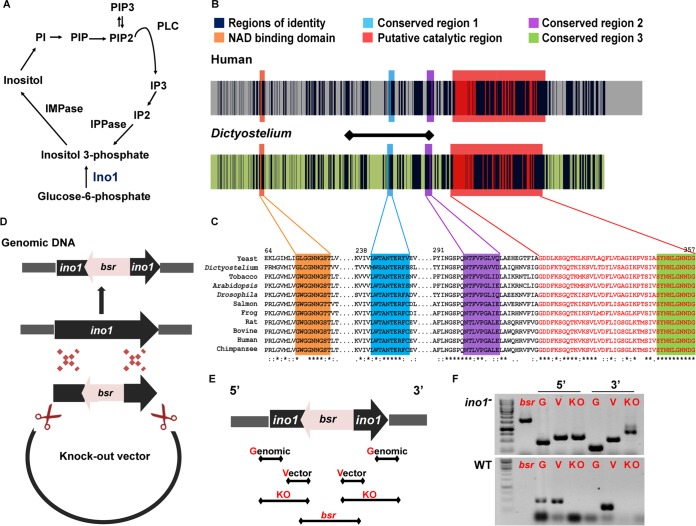FIG 1.
Inositol signaling and conservation of the Ino1 protein in Dictyostelium and humans. (A) Inositol metabolism. Ino1 converts glucose-6-phosphate to inositol-3-phosphate, which is a rate-limiting step in inositol production. (B) Sequence homology between the human (accession no. Q9NPH2-1) and Dictyostelium (accession no. Q54N49) Ino1 proteins is present throughout the protein sequences. Identical amino acids are shown in dark blue. The NAD binding and catalytic domains are among the four regions that are highly conserved in eukaryotic Ino1 proteins, i.e., for the human protein GWGGNNG (orange), LWTANTERY (blue), SYNHLGNNDG (green), and NGSPQNTFVPGL (purple). The tetramerization domain, containing a putative catalytic site (with the conserved amino acid residues SYNHLGNNDG), is shown in red. The amino acids that were ablated in Dictyostelium Ino1 are shown by the horizontal line. (C) Alignment of the conserved regions of Ino1 proteins from various species. Asterisks show identity, colons show high conservation levels, and dots show low conservation levels. (D) Schematic representation of the strategy used to prepare the ino1 knockout construct. 5′ and 3′ regions of the ino1 gene were cloned into a knockout vector at positions flanking the blasticidin resistance gene (bsr), and the knockout cassette was transformed into Dictyostelium cells, where homologous recombination deleted a portion of the ino1 gene and disrupted the open reading frame. (E) PCR screening strategy to identify ino1− mutants, showing primer locations for genomic and vector controls, the diagnostic knockout products (KO), and the area spanning the inserted bsr gene present in the ino1− knockout. (F) PCR results showing the ablation of part of the ino1 gene in the ino1− mutant in comparison to wild-type cells. Ino1, inositol-3-phosphate synthase; IMPase, inositol monophosphatase; IPPase, inositol polyphosphate 1-phosphatase; IP2, inositol bisphosphate; IP3, inositol trisphosphate; PLC, phospholipase C; PI, phosphatidylinositol; PIP, phosphatidylinositol phosphate; PIP2, phosphatidylinositol bisphosphate; PIP3, phosphatidylinositol trisphosphate; bsr, blasticidin resistance gene; G, genomic control; V, vector control; KO, knockout; 5′, region corresponding to the transcription initiation site of the ino1 gene; 3′, region corresponding to the transcription termination site of the ino1 gene.

